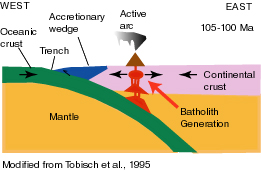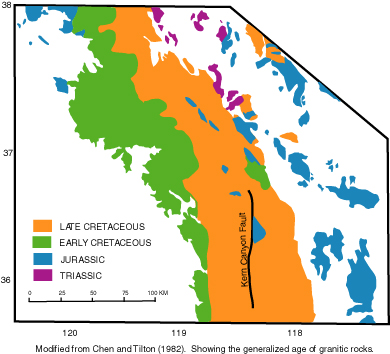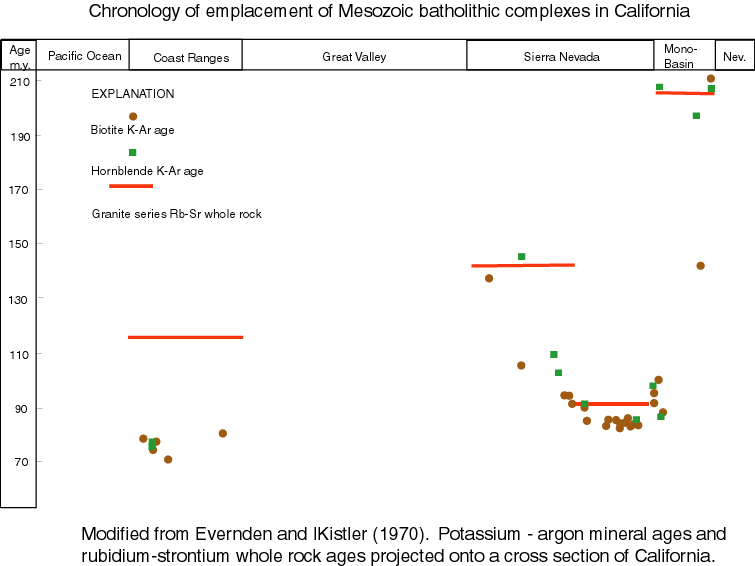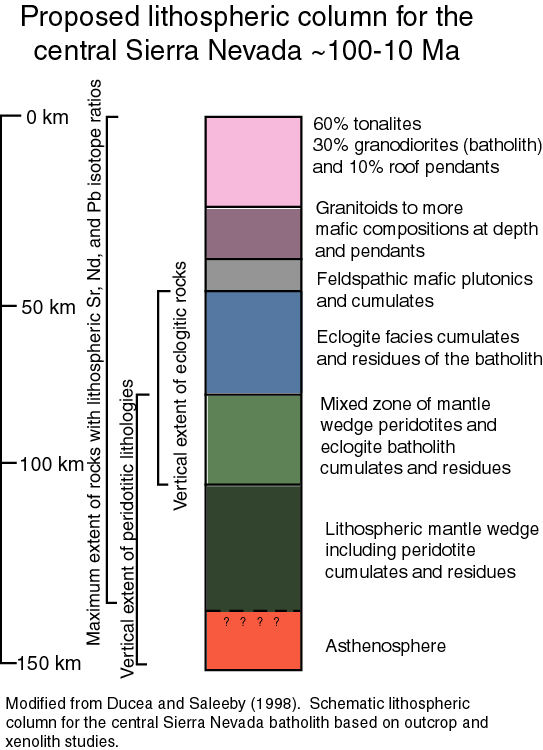
Mesozoic Plutonism in the central Sierra Nevada Batholith:
A review of works on mineralogy and isotopes in relation to models for batholith formation
Prepared by: Tanya S. Unger

II. Brief evolution of thought regarding the formation of the batholith
III. General tectonic setting at the time of batholith formation
a. Ages of plutonic rocks
b. Trends in elemental and isotopic data
c. Vertical trends from xenolith studies
VII. Using Rb-Sr and Sm-Nd get at sources for batholithic rocks
The problems associated with the origin and emplacement of the Sierra Nevada batholith are anything but trivial. Questions that have remained difficult to answer since Lawson’s 1937 seimic observations of the Sierra Nevada Range include and are not limited to the following:
1.) What was the nature of the western North American plate margin in Mesozoic time?
2.) What are the sources for magmas generated from Jurassic to Cretaceous time that make up the plutons of the Sierra Nevada batholith?
3.) How were these magmas emplaced?
4.) What is the compostion and age of the Sierra Nevada root?
In answering these questions, it is necessary to integrate geochemistry, geophysics, tectonics, and geology. Mineralogical and isotopic data suggests that the batholith has both vertical and lateral trends oweing themselves to the nature of magma generation and emplacement. This webpage is an effort to summarize select studies of the granitiod rocks of the Sierra Nevada batholith and present current interpretations of mineralogical and isotopic data.
Return to the top of this page
II. Brief evolution of thought regarding the formation of the batholith
Desiphering the tectonic history surrounding the generation and emplacement of the Sierra Nevada batholith has proved to be a difficult task involving the incorporation of geophysical, geochemical, and mineralogical data as well as field relationships amoung the plutons which intruded along the Paleozoic North American Craton between 210 - 80 Ma (Evernden et al. 1970). In his 1988 paper, Bateman provides an overview of the evolution of thought on the development of the Sierra Nevada batholith. Much of the focus on the Sierra Nevada batholith began with the 1937 interpretaion of seismic data by Lawson. From this study it was demonstrated that today there exists a 50 km root under the Sierra Nevada which is supporting the range. This root was thought to shallow to 35 km under the Great Basin. More recent studies have shown presently there is a thin crust under the Sierra Nevada (Wernicke et al. 1996). Nevertheless Lawson's original idea of a thick root supporting the Sierra Nevada range has only relatively recently disappeared from the literature.
Throughout the 60's and 70's the USGS began heavy data collection in the Sierra Nevada range to determine the timing and emplacement history of the Sierra Nevada batholith. Much of the mineralogy and geochemistry was carried out on samples from between 37° and 38° north latitude and 118° and 120° west longitude, this is taken to be the location of the central Sierra Nevada for the purposes of this page. Original studies in this area of the central Sierra Nevada were concerned with mineralogical and major/minor elemental changes across the batholith.
Moore (1962) suggested that the compositional variations in the plutons are representative of magmas generated in a thin sialic layer (west) verses a thick sialic layer (east).
Bateman (1963) demonstrated that compositional variations seen along a west-east transect across the batholith represent lower crustal magmas, generated from heat from radioactive decay, which intruded the long axis of a faulted synclinorium. This study suggested the Sierrian root formed concurrent with synclinorium during the Mesozoic. Bateman (1963) attributed west-east changes to the nature of the country rock and interpreted the magma generation to be an anatectic melt from those sources. However with the growing popularity of plate tectonics and no correlation of rock units on the western edge of the batholith with those on the east, the syncline ideas were abandoned.
Contrary to Bateman's Mesozoic root, Christensen (1966) believed that the root was not present prior to the Cenozoic uplift but was formed during the late Cenozoic rise of the Sierra Nevada range. Magma generation at depth was thought to have caused crustal thickening, resulting in synchronous uplifting of the Sierra Nevada region during the Cenozoic.
Hamilton and Moore (1970) proposed the idea that ophiolitic and island arc assemblages were swept against and subducted beneath the North American plate and the heat produced during subduction melted both mantle and lower crust producing granitic magma.
Kistler et al. (1971) were not in support of Bateman's idea of downwarping based on strontium istotopic data which suggested an upper mantle/lower crustal source for the granitoids of the Sierra Nevada. Kistler et al. (1971) also argued that different ages and pulses of magmatism not likely generated from constant heat from a radiogenic source alone. This study relied on K-Ar age data and argued against continuous production of magma. Kistler concluded that a linear heat source was responsible for the production of pulses of magmatism related to the change in position of the locus of magmatism over time as observed from the relative positions of the Jurassic and Cretaceous plutons.
Kistler and Perterman (1973) went on to suggest that the granitic magma formed above linear zones on melt from a resevoir which developed 1700 m.y. ago and Jurassic magmatism was fracture controlled.
Schweidkert and Cowan (1975) concluded that two partly coeval subduction zones that dipped outward from a core area of oceanic lithosphere existed off the coast of the North American craton. One west dipping plate beneath oceanic crust produced volcanism at the present western foothills and one eastward dippling plate beneath the continent produced volcanism east of the present high Sierra Nevada. This idea of coeval subduction zones would produce melts of varying compositions which would tend to get more sialic to the east. Magma generation ceased in both arcs when the intervening plate was consumed by subduction but the eastern subduction limb moved farther west and was renewed in the Late Jurassic producing complex stuctures in the California coast ranges and granitic magmas in the Sierra Nevada.
Hay (1976) suggested that Cenozoic uplift of the Sierra Nevada resulted from isostatic forces associated with a Mesozoic root and was initiated by the advent of the San Andreas system of right-lateral faulting when the Pacific and North American plates frist came into contact along the newly developed transform fault system. Hay argued that the rejuvenation of the range was further accelerated about 4.5 my ago in response to the northward migration of the Mendocino triple junction and the increased rate of motion between the North American and Pacific plates calling upon uplifted erosional surfaces which he terms "mountain valley erosional surfaces".
DePaolo (1981) interpreted Rb-Sr and Sm-Nd isotopes to be magma mixing between two contaminated end members and not evolution of source or changes in source.
In 1988 Bateman readdressed the issue of batholith emplacement on the western margin of North America and concluded that it is a consequence of convergence of the North American and Pacific plates resulting in an eastward dipping subduction zone. Bateman pointed to trends in the mineralogical and isotopic data to ask more question regarding the changes in the nature of subduction (i.e. rate and dip angle) and subseqent changes in the locus of magmatism. Was the pluton emplaced during extension or regional compression? How was the pluton emplaced (ie forcible, ballooning, or stoping)? Evidence in the Sierra Nevada batholith as described by Bateman (1988) would seem to suggest that all of these methods of emplacement were active at least in some part. Bateman suggests that possible causes for compositional and isotopic changes may be the result of:
increasing thickness of prebatholithic crust or larger crustal components of parent magma
increasing sedimentary component in crust
less depletion of the mantle component in such consitiuents as K, Ur, Th with distance from subduction zone.
Bateman (1988) also addressed the problem of creating space in the crust for the emplacement of this granite. Possiblities relating to the creating of space involve:
incorporation of crustal materials in the magma
forcible displacement of wall and roof rocks
stoping
extension across the area of the batholith
erosion and expulsion of volcanic materials generated in the crust
Bateman suggests a combination of the processes above provides space for the batholithic rocks.
Tobisch et al. (1995) demostrated that Mid- to Late Cretaceous plutons show widely preserved magmatic foliation whereas regional solid state foliation is abscent. This evidence was interpreted to represent relatively slow cooling at strain rates suggesting emplacement in a neutral or weakly extensional deformation regime. This paper highlights the younging of shear zones and plutons to the east. Timing of emplacement and movement in shear zones contrained by U-Pb (zircons) and 40/39 Ar (hornblende and biotite) geochronology. Older shear zones show steeply plunging stretching lineations whereas easterly and/or younger activity is represented by oblique and/or subhorizontal stretching lineations indicating change in kinematics ~90 Ma. This model points to slab flattening which causes the neutral or weak extensional regime to move east away from the trench (see figure below) .


Return to the top of this page
II. General tectonic setting at the time of batholith formation
The Sierra Nevada Range is thought to be the result of Cenozoic westward tilting of a block of crust including the Mesozoic age plutonic rocks comprising the Sierra Nevada batholith (Bateman 1988). Paleozoic to Mesozoic allocthonous metamorphosed sedimentary and volcanic rocks lie west of the Sierra Nevada. East of the range are autocthonous sedimentary rocks (Bateman 1988). The Sierra Nevada batholith was emplaced into strongly deformed but weakly metamorphosed Proterozoic to Cretaceous rocks along the Paleozoic North American craton. These country rocks were deformed during the Antler, Sonoman, and Nevadan Orogenies and during emplacement and exhumation of the granitoid rocks of the Sierra Nevada batholith. Structures parallel the long axis of the Sierra Nevada (Bateman 1988).
Magmatism began in the Late Triassic (~210 Ma), approximately coincident with breakup of Pangea. Magmatisim continued episodically into the Cretaceous (~85Ma). There is world wide association of batholiths with zones of convergence and continental margins. Ophiolites present in western foothills are widely interpreted as representatives of the accretionary wedge settings (Bateman, 1988).
Generation of intrusive suites involved melting and mixing of source materials and country rocks. Magma generation began with rise of heat and basaltic magma from mantle into the lower crust (DePaolo, 1980; Domenick, 1983). Isotopes indicate the existance of only one locus of magmatism at any given time and that it shifted episodically (Bateman, 1988). Shifts and renewed magmatic activity triggered by accretion of exotic terranes, advancement or retreat of subducting plate, or changes in the rate of subduction or dip angle (Bateman, 1988).
Chen et al. (1982) calculated that the large volume intrusions of Cretaceous granites began 120 my ago in western Sierra Nevada and migrated steadily eastward for 40 m.y. at a rate of 2.7 mm/yr. This slow and constant migration is interpreted to indicate uniform subduction conditions with perhaps downward migration of parent magma generation or slight flattening of subduction zone (Chen et al. 1982). Abrupt termination of plutonism at 80 Ma indicates an increasing rate of convergence of American and eastern Pacific Plates and dramatic flattening of the subduction zone.

Return to the top of this page
Ages of plutonic rocks:
Stern et al. (1981) examined the zircons of 62 samples of granitoid sequences, in the central Sierra Nevada, via U-Pb dating techniques. This paper reports three distinct trends in the age data:
~210 Ma on the east side of the batholith
in a single, extensive Triassic sequence
186-155 Ma on both east and west margins of the batholith
125-88 Ma granitoids, which young eastward, in the axial part of
the batholith

In addition it is reported that Jurassic plutons trend N40W and Cretaceous trend N20W. This offset is thought to represent plate movements between the Jurrassic and Cretaceous magmatic events. The map above is generalized from a paper by Chen and Tilton (1982) which investigates the U-Pb ages of granitoid rocks. The authors report age ranges from 217-80 Ma in the eastern and southern Sierra Nevada and conclude excellent agreement between the K-Ar and U-Pb methods of dating samples from the western foothills and the eastern Sierra crest. This work correlates well with work done by Stern et al. (1981) and Evernden and Kistler (1970) in the central Sierra Nevada (seen below).

In summary, the Cretaceous magmatism intruded the Jurassic and Triassic plutons. There seems to be little evidence that the Jurassic and Triassic plutons young to the east. However, there is evidence to suggest that the Cretaceous magmatism youngs eastward (Evernden and Kistler (1970), Bateman (1970), Chen and Tilton (1982), and Kistler et al. (1965)). This has implications for the tectonic models of the area. Some interpretations involve flattening of the subducting slab with time thus producing an eastward migration in the focus of magmatism throughout the Cretaceous. Continued flattening eventually leads to a cessation of plutonic magmatism. To review a shematic of this model click here.
Trends in elemental and isotopic data:
| Major Elements | WEST | EAST |
| Quartz | irregular ranges 20-30% in most of SN | rises to 35% in White Mountains |
| Alkali Feldspar | ~ 4% | ~30% |
| Plagioclase | ~< 60% | ~30% base of Sierra Nevada; slight
rise in Inyo Mountains |
| Mafics | irregular ~14% | 4% base of Sierra Nevada; rise to
~10% in Jurassic Rocks of White Mountains but decrease in Cretaceous rocks |
| K2O | increase eastward | |
| CaO, FeO, Fe, Mg | decrease eastward | |
| Summary of Major Element Data |
more mafic | more sialic |
| Minor/REE | ||
| U, Th, Rb, Ba, Ta, Be | increase eastward | |
| LREE (from sphene and apatite) |
increase eastward | |
| Isotopes | ||
| 87/86 Sr initial | <0.704 | 0.708 |
| 143/144 Nd initial | decrease eastward | |
| eNd | 6.5 | -7.6; decrease eastward |
| 206/204 Pb | ~18.6 in west; 19.5 in middle | decrease regularly to ~18.5 in east |
| Crystallization Pressure | broad increase eastward | |
| Plutons | young to the east | |
| Ductile Shear Zones | 4 westerly shear zones active 100-90 Ma weakly extensional |
younger; mostly oblique/ subhorizontal stretching lineations active 88-78 Ma |
Data in this table
comes from Bateman (1988), Bateman et al. (1970), Hurley et al.
(1965), Kistler et al. (1973)
Dodge et al.(1982), Dodge et al. (1972), DePaolo (1981), Tobisch
et al. (1995), and Ague et al. (1988).
Vertical trends from xenolith studies:

Ducea et al. (1998) presented evidence for a thick ~100km sequence of cogenetic rocks representing the crustal and continental mantle lithosphere components of the Sierra Nevada batholith (pictured above). Sierran magmatism produced tonalitic and granodioritic magmas upper-mid crust as well as upper mantle mafic to ultramafic cumulates. These rocks were sampled by Cenozoic volcanics and are preseved as xenoliths. Reports of equilibration of these xenoliths suggest that they formed 35 and 100 km beneath the batholith at the time of Cretaceous magmatic activity.
In 1993, Pickett et al. studied aluminum contents of hornblendes to get thermodynamic estimates of pressures, temperatures, and volatile contents in deformed rocks of the Sierra Nevada batholith and the Tehachapi Mountains. His data implies pressures of igneous emplacement of ~8 kbar with lower pressures in the north (3-7 kbar). The gabbroic to granitic intrusives of the Tehachapi Mountains represent the deepest exposures of batholithic cumulates formed at depth of 25-30 km. This data suggests that the southern part of the batholith has uplifted more than the northern end. One interpretation is that the southern Sierra Nevada batholith has been subjected to uplift longer than the northern end of the batholith.
Return to the top of the page | Go to isotope systematics page | Go to References